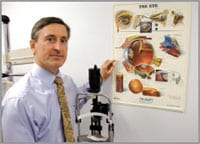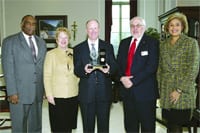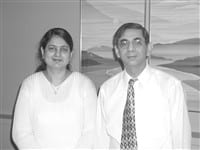Seeing Is Believing New Intraocular Lens Offers an Intriguing New Solution
Failing eyesight due to cataracts affects millions of Americans annually. And thus far, the options for intraocular lenses (IOL) to replace the damaged lenses have been somewhat limited in scope. But it’s only a matter of time before those choices become a bit clearer.
It’s still officially in rigorous federal testing stages, but when the FDA approves Synchrony lenses for use, they will revolutionize the market for patients needing intraocular lens implants, primarily those requiring cataract surgeries.
So says Dr. Kevin Hulseberg of Holyoke’s Pioneer Valley Eye Associates, and recently he told the HCN how this new technology is a vast improvement over what is currently available.
“Until this time, IOLs in cataract surgery have been limited in that we could put a single lens inside the eye to replace the lens that turned into a cataract,” he explained. “But it only had one focal length, meaning you could see far away. Any other correction to read up close, or read intermediate distance — computers, store shelves — and you needed to rely on glasses.”
Around a decade ago, a multi-focal, single-plate optic was developed. Using either molding or laser inscription, two separate focal lengths we incorporated onto the lens, for far and near sight. But there were some problems with this technology, Hulseberg said.
“As incoming light hits all these edges in the lens,” he said, “there is a diffractive error, and people will see a glow, or a halo effect around lights. Between 7{06cf2b9696b159f874511d23dbc893eb1ac83014175ed30550cfff22781411e5} and 12{06cf2b9696b159f874511d23dbc893eb1ac83014175ed30550cfff22781411e5} of people would actually ask for that lens to be removed, they found it so distracting.”
And so, the “holy grail of ophthalmology,” as he called it, has been for an intraocular implant — a lens placed within the eye — to have the ability to adapt, to use certain muscles within the eye that allow it to focus on objects at differing distances — “what we had when we were 20 years old,” he said.
Enter the technology that is called Synchrony, developed by California-based Visiogen. Synchrony utilizes two separate lenses, attached by micro “struts.” Hulseberg described their function. “They’re attached together much like a telescope. And with that, it can focus out into the distance, or bring the focus intermediate, or very fine, up close. This is the first time that we have had something to accommodate, to use the ciliary muscles that we were born with, to adapt and control what our vision focuses upon, whether something is one foot away or 300 feet away.”
Sitting down recently with HCN, Hulseberg went into detail about Synchrony, and how this technology has him, other doctors, and, most importantly, his patients all expectantly waiting for the option that by all accounts seems to make their decisions for corrective IOLs crystal clear.
The Sharper Image
In order to clarify the distinction between the old and new technologies, Hulseberg described the traditional process for intraocular implants.
“There’s a container inside the eye — we call it the capsule — and inside that is the lens of the eye,” he explained. “That capsule has little attachments, like ligaments to bone, called zonules, attaching the lens to the ciliary muscle.
“When we do cataract surgery today,” he continued, “we remove the front portion of that capsule, take out the lens, and essentially have this empty ‘plastic bag.’ When we complete the surgery, and get rid of the cataract, the artificial lens is then tucked right into that capsule, the plastic bag.”
The installation of Synchrony isn’t that much different, he said, and the Visiogen Web site describes the process in greater detail. It explains that Synchrony lenses are pre-loaded into a straw-like injector, eliminating the need for the device to be handled prior to installation. The lenses unfold into the capsule upon insertion. The rear lens has a greater surface area than the fore lens, allowing the device to be seated more accurately within the capsule.
In lay terms, according to Hulseberg, “there’s a lens for the front and the back of the ‘bag’ that has those struts holding them together. When we place it back into the capsule, as the ciliary muscle relaxes, it separates the lenses, and as it tightens, it pulls flatter together — like a zoom lens.”
Patients with pre-existing IOLs can opt to have Synchrony installed, he said, adding that the surgical techniques are the same for both. “Maybe a bit larger of an incision to get the additional size of the new device in,” he speculated.
As the device has yet to hit the marketplace, the $64,000 question is the cost of Synchrony, compared to multi-focal single lenses.
“It’s going to come down to insurance coverage for many,” he said. “Right now, single-focus lenses are covered, and some choose to upgrade to the multifocal single lenses. That’s roughly $900 additional for each lens. But right now, we have no idea what the additional expense of Synchrony will be.”
When asked if the technology renders the existing IOLs obsolete, he again referenced the bottom line.
“The way that health care exists today,” he said, “it’s going to be acceptable to put in a monofocal lens. But in practicality, I think the vast majority of people are going to find the freedom to see the way they did when they were 20 will make a big difference to them. If they can afford it, I’m sure they will want this.”
Synchrony has been in use in Europe for close to three years, and Hulseberg said that the reports of the mechanical performance of the lenses are sound.
“If you read the European studies,” he said, “you’ll find that there’s been excellent feedback.”
The construction of the device does give him some ever-so-slight degree of pause. After all, this does replace a single object — one lens — with a highly specialized piece of machinery with a series of mechanical movements. But those studies he’s read show 40- and 50-year wear simulation tests, with no strut failures whatsoever.
Coming into Focus
Hulseberg said he is ready to hit the ground running and offer Synchrony to his patients as soon as it becomes available.
“We were one of the first locations to offer intraocular implants,” he said. “We are expectantly waiting for the FDA to give the green light.”
He encourages patients to have a conversation with their own eye specialists as to whether this technology is something that is right for them.
“You want to have an understanding of everything that will be available, in addition to what is already available,” he told HCN. “Cataract surgery is an elective procedure, meaning that the timing of it is in the hands of the patient. If you’d rather wait six months to a year to have the option of something better, then I think it behooves us as doctors to make this known to our patients. I’ve had this discussion with many of my patients that are in that zone where their cataracts aren’t terribly bad, and it might make sense to wait.”
But when Synchrony is ultimately approved for use in the U.S., Hulseberg sees it as a breakthrough option.
“Even today, if someone is 20 years old, they can have Lasik,” he said, referencing the laser corrective eye surgery, “or they can opt for an IOL. Those people will do great until maybe they’re 40, and then they are going to need reading glasses like everyone else. Because, once we hit 45, that presbyopia — age-based diminished eye performance — gets greater on into the 50s and 60s.
“Some people who might be close to that 40-year mark, if they’re going to make the decision between Lasik and this newer lens,” he continued, “I’ll bet most of them will take the newer lens. Then they’re not going to worry about what will need to happen again in five years.”
After all, he added, “this is a surgery that you ideally only want to have once.”



